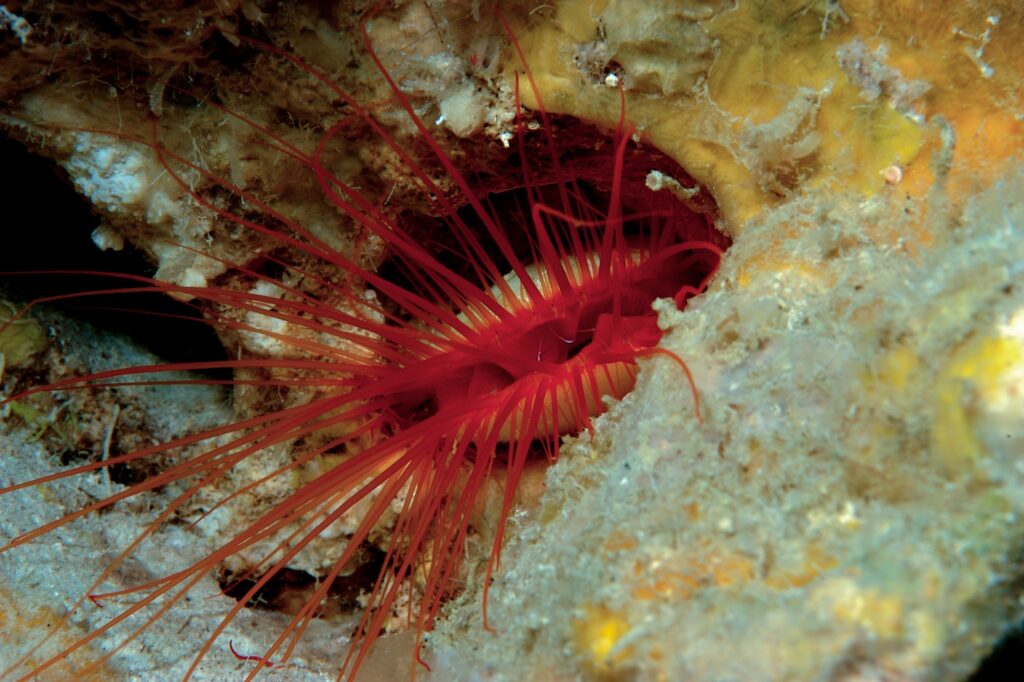Disco Clam
C. ales
Can spray acidic mucus at predators
Advertisement
Disco Clam Scientific Classification
- Kingdom
- Animalia
- Phylum
- Mollusca
- Class
- Bivalvia
- Order
- Limida
- Family
- Limidae
- Genus
- Ctenoides
- Scientific Name
- C. ales
Read our Complete Guide to Classification of Animals.
Disco Clam Conservation Status
Disco Clam Facts
- Prey
- Plankton
- Name Of Young
- Larvae
- Group Behavior
- Solitary
- Fun Fact
- Can spray acidic mucus at predators
- Estimated Population Size
- Unknown
- Biggest Threat
- Climate change
- Most Distinctive Feature
- Flashing light display
- Distinctive Feature
- Red tentacles
- Other Name(s)
- Electric flame scallop, electric clam, disco scallop
- Habitat
- Coral reefs
- Predators
- Mantis shrimp
- Diet
- Omnivore
- Special Features
- Can swim using its tentacles
- Number Of Species
- 1
- Location
- Indo-Pacific
- Nesting Location
- Cracks and crevices
View all of the Disco Clam images!
Ctenoidea ales is better known by its common name, the disco clam. This unique marine bivalve mollusk belongs to the family Limidae. Along with the rough file clam, it’s one of the only two bivalves known to emit flashing light. You can find these clams throughout the waters of the central Indian and Pacific Oceans. Scientists continue to debate the purpose of their flashy display.
5 Disco Clam Facts
- The disco clam earned its name because its light displays resemble a disco ball or neon light.
- One of the clam’s lips contains extremely small silica spheres that reflect light, which – when absorbed by the other lip – create the illusion of flashing.
- The bright red portion of the disco clam’s mantle possesses noxious peptide-like compounds that predators may find distasteful.
- They can spray acidic mucus to ward off predators.
- Plankton are the primary food source of disco clams, and as plankton populations decline, so too do disco clams.
Disco Clam Classification and Scientific Name
The disco clam belongs to the phylum Mollusca, the second-largest phylum of invertebrates after Arthropoda. All roughly 85,000 known species of Mollusca go by the collective name molluscs (mollusks). Most mollusks belong to the class Gastropoda, which includes all snails, slugs, limpets, and conches. Meanwhile, the disco clam belongs to the class Bivalvia, which includes clams, oysters, scallops, geoducks, and mussels. The Swedish scientist and “father of modern taxonomy,” Carl Linnaeus, first used the term Bivalvia in 1758. It stems from the Latin words bis, meaning “two,” and valvae, meaning “leaves of a door.” Roughly speaking, the name refers to the fact that bivalves possess paired shells with two valves or halves.
The disco clam is a member of the file shell family Limidae. In total, the family consists of 130 known species divided among 10 genera. The disco clam belongs to the genus Ctenoides. The genus name stems from the Ancient Greek word κτείς (kteis), meaning “comb.” This name refers to ctenoids’ long tentacles that – when their valves are half-closed – resemble the teeth of a comb. Meanwhile, the disco clam’s specific name, ales, stems from the Latin word ales, meaning “winged, aerial,” or “quick.” Its specific name likely has to do with its ability to swim by waving its tentacles through the water.
The disco clam goes by many common names, including the electric flame scallop, electric clam, and disco scallop. All of these names stem from the flashy light displays it emits along the edges of its soft lip tissue. That said, these displays have nothing to do with electricity, despite what the names may lead you to believe.
Disco Clam Appearance

Most disco clams measure between an inch and two and a half inches long.
©Brad Fish/Shutterstock.com
Disco clams range in size, with most measuring around 1 to 2.5 inches long. That said, large specimens can reach up to 4 inches. Their shells look mottled tan, while the clam’s mantle tissue appears bright reddish-orange. Dozens of long bright red tentacles grow out of the shell and mantle. These tentacles vary in terms of length, with some measuring longer than the clam itself. Disco clams possess over 40 nano-sized eyes nestled in between their tentacles.
The most noticeable feature of disco clams is the characteristic flashing lights they create along the edge of the mantle tissue. These flashing lights are not a form of bioluminescence but rather a result of ambient light reflection. Disco clams possess highly reflective silica spheres along the outer edge of one side of their mantle. When these spheres catch the light, they briefly reflect the light back outward. The other side of the mantle lip then catches and absorbs this light, thereby creating an asynchronous light display. The effect of this reflection resembles arcing electricity, hence the name “electric clam.”
Distribution, Population, and Habitat
Disco clams live in tropical waters throughout the Indian and Pacific Oceans. They occur most often in the central Indo-Pacific. You can find them in the waters between Indonesia and New Caledonia off the coast of eastern Australia.
Although they can swim, they spend most of their time attached to coral reefs or other rocky outcroppings. They tend to burrow into relatively dark crevices and crannies where they can hide from predators. You’re most likely to encounter them at depths between 10 and 160 feet below the surface.
Predators and Prey
Numerous marine organisms prey on disco clams. Common predators include fish, crustaceans, cephalopods, and whelks. The mantis shrimp is one of the disco clam’s main predators. Scientists believe that the clam’s flashing light display acts as a form of predator deterrence. The bright red portion of their mantle contains foul-tasting peptide-like compounds. Most likely, flashing lights are their way of letting predators know, “I don’t taste good, move on.” But flashing lights aren’t their only means of protecting themselves. In laboratory conditions, scientists have gotten disco clams to spray acidic mucus at mantis shrimp. This mucus acts as a final line of defense in case a potential predator won’t back off.
Disco clams are omnivores that primarily consume plankton. They eat by filtering water through their siphons and gills, which trap food particles in a sticky mucus. Although they do not prey on fish or larger organisms, they may consume fish scraps and other organic debris.
Reproduction and Lifespan
Little is known about their reproduction and lifespan. Despite possessing around 40 eyes, they have poor eyesight. As a result, their light display likely has little to do with finding a mate, although it may play a role in attracting a mate. They reproduce via broadcast spawning, wherein the male and female clams both release their gametes into the water. The average number, size, and color of disco clam eggs remain unknown. According to some estimates, disco clams can live for up to 30 years.
Disco Clam in Food and Cooking
As far as we can tell, disco clams do not feature prominently in traditional or modern cuisine. That said, if necessary, you could cook and eat disco clams. However, cooking methods and flavor remain unknown. Most people cook clams by steaming them in a colander or steamer for around two minutes. Once the shells open, they are ready to eat. You can also cook clams in hot liquid, sauce, or a jus. Always make sure to properly scrub and wash clams before you eat them to remove any debris. Clams feature prominently in numerous dishes, including clam chowder, spaghetti alle vongole, clam cakes, and clam rice.
Population
Presently, the disco clam is Not Evaluated by the IUCN or any other regulatory agency. Disco clams occur in large numbers within their native range. However, some evidence suggests that populations in the wild are on the decline. This decline likely stems from the availability of plankton. If disco clams cannot collect enough plankton, they cannot feed themselves or reproduce. Climate change and changes in ocean temperatures can impact the ability of plankton to proliferate. This, in turn, affects disco clams and other marine organisms that rely on plankton.
View all 110 animals that start with DDisco Clam FAQs (Frequently Asked Questions)
Are disco clam carnivores, herbivores, or omnivores?
Disco clams are omnivores that primarily feed on plankton. They may also consume other organic material, including fish poop and carrion.
Where can you find disco clams?
Disco clams range throughout the Indo-Pacific between Indonesia and Australia. They mostly live along coral reefs at depths between 10 and 160 feet below sea level.
Are disco clams endangered?
Currently, disco clams are not listed as Endangered by the IUCN or any other regulatory agency. That said, some evidence suggests that disco clam populations are declining due to climate change and changes in the availability of plankton, their primary food source.
Are disco clams poisonous?
The red tissue of a disco clam possesses noxious peptide-like compounds that taste rather foul. They can also spray acidic mucus when threatened. However, their white flesh is edible.
Thank you for reading! Have some feedback for us? Contact the AZ Animals editorial team.
Sources
- 03/08/2023, Available here: https://www.colorado.edu/cumuseum/2021/01/06/disco-clams
- 03/08/2023, Available here: https://www.nationalgeographic.com/animals/article/150106-disco-clams-animals-science-oceans-light-predators
- 03/08/2023, Available here: https://www.colorado.edu/today/2019/11/18/colorful-sea-creatures
- 03/08/2023, Available here: https://magazine.scienceconnected.org/2020/01/disco-clam-colorful-mystery/
- 03/08/2023, Available here: https://www.livescience.com/49312-why-disco-clams-flash.html
- 03/08/2023, Available here: https://www.wired.com/2015/05/absurd-creature-of-the-week-disco-clam/

















